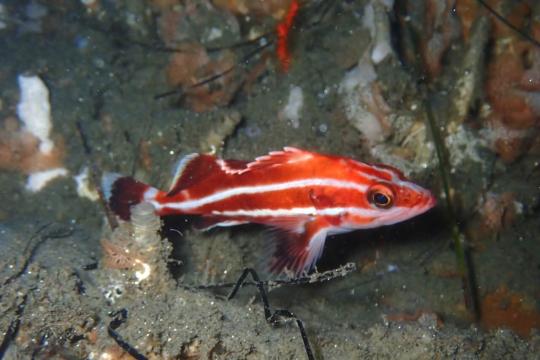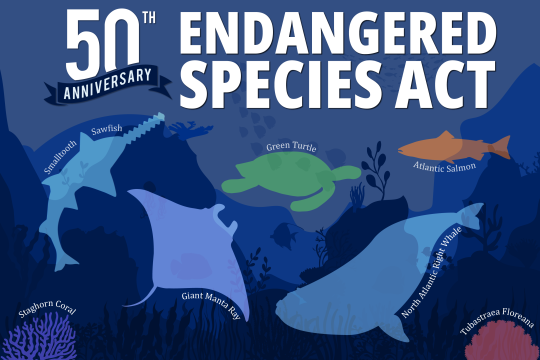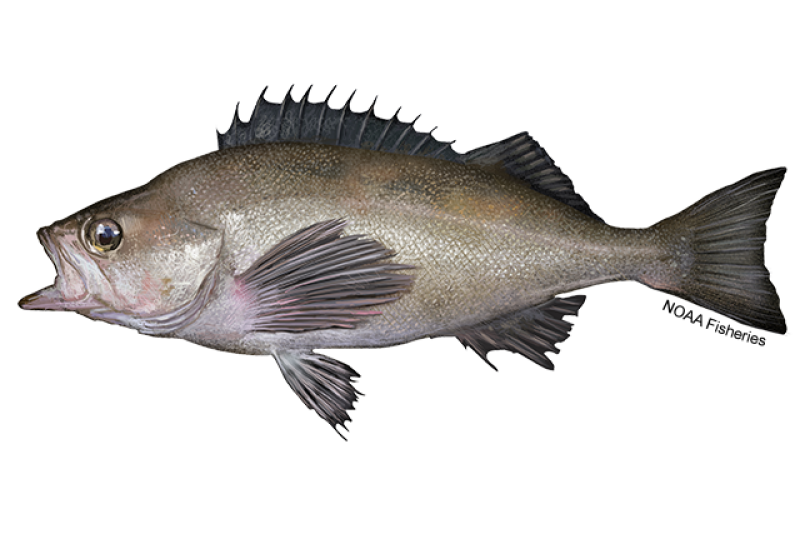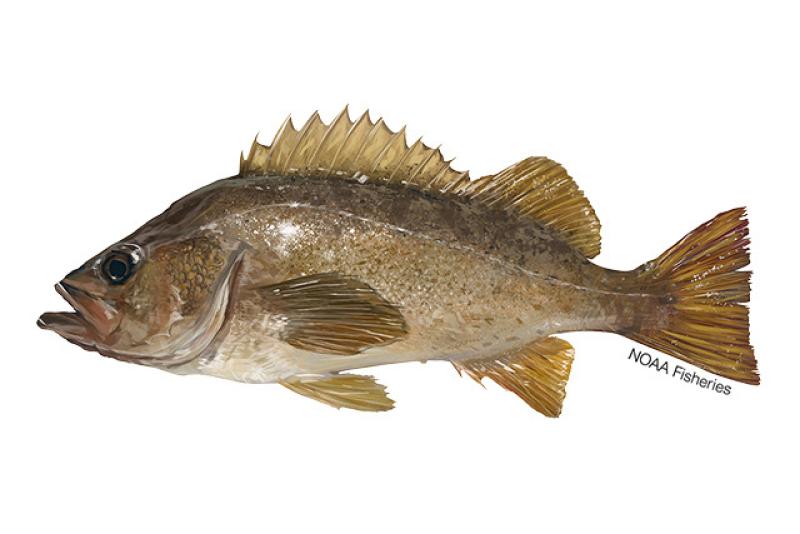Bocaccio
Sebastes paucispinis

Quick Facts
 Fisherman shows fished bocaccio. Credit: NOAA Fisheries
Fisherman shows fished bocaccio. Credit: NOAA Fisheries
Fisherman shows fished bocaccio. Credit: NOAA Fisheries
About the Species
 Fisherman shows fished bocaccio. Credit: NOAA Fisheries
Fisherman shows fished bocaccio. Credit: NOAA Fisheries
Fisherman shows fished bocaccio. Credit: NOAA Fisheries
Bocaccio are large Pacific coast rockfish that are slow-growing, late to mature, and long-lived. They range from Punta Blanca, Baja California, to the Gulf of Alaska off Krozoff and the Kodiak Islands, but are most common between Oregon and northern Baja California. Having struggled to recover from overfishing, the Puget Sound/Georgia Basin distinct population segment of bocaccio is listed as endangered under the Endangered Species Act. Non-ESA listed populations of bocaccio are harvested in commercial and recreational fisheries off the West Coast and Alaska.
Learn about the Pacific Coast Groundfish Fishery off the West Coast

Population
The Southern Pacific Coast stock is not overfished.

Fishing Rate
Not subject to overfishing.

Habitat Impact
Area closures and gear restrictions protect sensitive rocky, cold-water coral and sponge habitats from bottom trawl gear.

Bycatch
Regulations are in place to minimize bycatch.
Population Status
- There are three stocks of bocaccio: Southern Pacific Coast, one stock contained in a stock complex along the northern Pacific coast, and one stock contained in a stock complex in the Gulf of Alaska. According to the most recent stock assessments:
- The Southern Pacific Coast stock is not overfished (2017 stock assessment) and not subject to overfishing based on 2022 catch data. Summary stock assessment information can be found on Stock SMART. This stock had been overfished and was successfully rebuilt in 2017.
- Bocaccio is managed as part of the Minor Shelf Rockfish North Complex, but has not been assessed so the overfished status is unknown. The complex is not subject to overfishing based on 2022 catch data.
- Bocaccio is managed as part of the Gulf of Alaska Other Rockfish Complex and has been assessed, but there is not enough information to determine the population size so the overfished status is unknown (2023 stock assessment). This complex is not subject to overfishing based on 2023 catch data. Summary stock assessment information can be found on Stock SMART.
Appearance
- Bocaccio can grow up to three feet long and weigh up to 21 pounds.
- They are identifiable based on their long jaw, which extends to or past the eye socket.
- Young bocaccio are light bronze with small brown spots along their sides. As they grow older, they lose their spots and darken.
- Adult bocaccio have backs that are olive, burnt-orange or brown as adults. They have pink and red stomachs.
Biology
- Bocaccio is a species of rockfish. Rockfishes are unusual among the bony fishes in that fertilization and embryo development is internal and female rockfish give birth to live larval young.
- Like most other species of rockfish, bocaccio are long-lived. Bocaccio mature and begin to reproduce between ages 4 and 7 years old, and they can live to be 50 years old.
- Bocaccio larvae are opportunistic feeders. Early on, larvae mostly eat copepod nauplii and eat some invertebrate eggs. As they grow, larvae start eating copepodites, adult copepods, and euphausiids.
- Within the first year of their lives, bocaccio begin foraging on other young fishes.
- Adult bocaccio mostly eat fish. Their preferred meal is other rockfishes, but they will also eat sablefish, anchovies, lantern fish and squid.
- Female bocaccio may spawn one to three times per season. They are highly fecund for rockfish and have been recorded with anywhere from 290 thousand up to 1.9 million eggs in the ovaries at one time.
- In the Southern California Bight, Bocaccio spawn from October to July, peaking in January. Off central and northern California, Bocaccio spawn from January to May and peak in February.
Where They Live
Range
- Bocaccio are found between Punta Blanca, Baja California, and the Gulf of Alaska off Krozoff and Kodiak Islands. Within this range, bocaccio is most common between Oregon and northern Baja California.
- There are two partially isolated populations; one southern population centered in California, and one northern population centered in British Columbia.
Habitat
- As bocaccio age, they switch from free-swimming pelagic habitat to bottom-oriented demersal habitat.
- Larvae and young-of-the-year bocaccio live in the upper layers of the ocean for several months.
- Juveniles settle nearshore in bottom habitats, such as rocky areas or kelp forests, and form schools.
- As juveniles mature, they move offshore to greater depths.
- Adult bocaccio primarily inhabit rocky habitats from 130 to 980 feet deep. They also live on coral and sponge reefs, and even artificial structures such as oil platforms.
- Several sources describe bocaccio as a midwater species during at least part of its adult phase.
Fishery Management
- NOAA Fisheries and the Pacific Fishery Management Council manage the bocaccio fishery on the West Coast.
- Along the southern Pacific coast, bocaccio are managed as a single stock. Along the northern Pacific coast, they are managed as part of the Minor Shelf Rockfish North Complex.
- Managed under the Pacific Coast Groundfish Fishery Management Plan:
- Permits and limited entry to the fishery.
- Limit on how much may be harvested in one fishing trip.
- Certain seasons and areas are closed to fishing.
- Gear restrictions help reduce bycatch and impacts on habitat.
- A trawl rationalization catch share program that includes:
- Catch limits based on the population status of each fish stock and divided into shares that are allocated to individual fishermen or groups.
- Provisions that allow fishermen to decide how and when to catch their share.
- NOAA Fisheries and the North Pacific Fishery Management Council manage the bocaccio fishery in the Gulf of Alaska. Bocaccio are managed as part of the Gulf of Alasks Other Rockfish Complex.
- Managed under the Fishery Management Plan for Groundfish of the Gulf of Alaska:
- There is no directed fishing for this species in Alaska, and only minor amounts are landed incidentally in other fisheries.
- Permits are required.
- Bottom contact gear is prohibited in the Gulf of Alaska Coral and Alaska Seamount Habitat Protection Areas to protect sensitive habitat.
- Gear restrictions help reduce bycatch.
- Annual catch limits are in place to prevent overfishing.
Harvest
- Commercial fishery
- In 2023, commercial landings of bocaccio totaled 1 million pounds and were valued at approximately $650,000, according to the NOAA commercial fishing landings database.
- types, habitat impacts and bycatch
- Bottom trawl gear is the predominant fishing gear used to catch bocaccio.
- Bottom trawls may sometimes catch other species of fish, including overfished and protected species.
- Gear restrictions, closed areas, and catch share programs limit when, where, and how much trawl fishermen can harvest to reduce bycatch of other species.
- Rockfish conservation areas eliminate fishing in areas on the West Coast where overfished rockfish species co-occur with target stocks, like canary rockfish. These closed areas help prevent bycatch of overfished rockfish.
- Recreational fishery
- Bocaccio is an important recreational fish in state waters.
- In 2021, recreational anglers landed 185,000 pounds of bocaccio, according to the NOAA Fisheries recreational fishing landings database.
- State agencies encourage anglers to avoid catching rockfish intentionally, to deep-water release all released rockfish, and to relocate if they unintentionally catch rockfish.
Scientific Classification
- Bocaccio are found between Punta Blanca, Baja California, and the Gulf of Alaska off Krozoff and Kodiak Islands. Within this range, bocaccio is most common between Oregon and northern Baja California.
- There are two partially isolated populations; one southern population centered in California, and one northern population centered in British Columbia.
- As bocaccio age, they switch from free-swimming pelagic habitat to bottom-oriented demersal habitat.
- Larvae and young-of-the-year bocaccio live in the upper layers of the ocean for several months.
- Juveniles settle nearshore in bottom habitats, such as rocky areas or kelp forests, and form schools.
- As juveniles mature, they move offshore to greater depths.
- Adult bocaccio primarily inhabit rocky habitats from 130 to 980 feet deep. They also live on coral and sponge reefs, and even artificial structures such as oil platforms.
- Several sources describe bocaccio as a midwater species during at least part of its adult phase.
Fishery Management
- NOAA Fisheries and the Pacific Fishery Management Council manage the bocaccio fishery on the West Coast.
- Along the southern Pacific coast, bocaccio are managed as a single stock. Along the northern Pacific coast, they are managed as part of the Minor Shelf Rockfish North Complex.
- Managed under the Pacific Coast Groundfish Fishery Management Plan:
- Permits and limited entry to the fishery.
- Limit on how much may be harvested in one fishing trip.
- Certain seasons and areas are closed to fishing.
- Gear restrictions help reduce bycatch and impacts on habitat.
- A trawl rationalization catch share program that includes:
- Catch limits based on the population status of each fish stock and divided into shares that are allocated to individual fishermen or groups.
- Provisions that allow fishermen to decide how and when to catch their share.
- NOAA Fisheries and the North Pacific Fishery Management Council manage the bocaccio fishery in the Gulf of Alaska. Bocaccio are managed as part of the Gulf of Alasks Other Rockfish Complex.
- Managed under the Fishery Management Plan for Groundfish of the Gulf of Alaska:
- There is no directed fishing for this species in Alaska, and only minor amounts are landed incidentally in other fisheries.
- Permits are required.
- Bottom contact gear is prohibited in the Gulf of Alaska Coral and Alaska Seamount Habitat Protection Areas to protect sensitive habitat.
- Gear restrictions help reduce bycatch.
- Annual catch limits are in place to prevent overfishing.
Harvest
- Commercial fishery
- In 2023, commercial landings of bocaccio totaled 1 million pounds and were valued at approximately $650,000, according to the NOAA commercial fishing landings database.
- types, habitat impacts and bycatch
- Bottom trawl gear is the predominant fishing gear used to catch bocaccio.
- Bottom trawls may sometimes catch other species of fish, including overfished and protected species.
- Gear restrictions, closed areas, and catch share programs limit when, where, and how much trawl fishermen can harvest to reduce bycatch of other species.
- Rockfish conservation areas eliminate fishing in areas on the West Coast where overfished rockfish species co-occur with target stocks, like canary rockfish. These closed areas help prevent bycatch of overfished rockfish.
- Recreational fishery
- Bocaccio is an important recreational fish in state waters.
- In 2021, recreational anglers landed 185,000 pounds of bocaccio, according to the NOAA Fisheries recreational fishing landings database.
- State agencies encourage anglers to avoid catching rockfish intentionally, to deep-water release all released rockfish, and to relocate if they unintentionally catch rockfish.
Scientific Classification
| Kingdom | Animalia | Phylum | Chordata | Class | Actinopterygii | Order | Scorpaeniformes | Family | Scorpaenidae | Genus | Sebastes | Species | paucispinis |
|---|
Last updated by NOAA Fisheries on 03/26/2025
Featured News
 Juvenile Yelloweye Rockfish. Credit: Dave Whitmer
Juvenile Yelloweye Rockfish. Credit: Dave Whitmer
 Recreational anglers fish for rockfish on a recreational fishing boat off Southern California. Photo: Mark Kalez
Recreational anglers fish for rockfish on a recreational fishing boat off Southern California. Photo: Mark Kalez
California Charter Boats Contribute to Rockfish Research, Support Sustainable Fishing

The Endangered Species Act: 50 Years of Conserving Species
 Cowcod dwell at depths up to 1,500 feet or more where they experience the high pressure of the surrounding water. Scientists attached tags to some fish to track their survival. Photo credit: NOAA Fisheries/SWFSC/Fisheries Research Division
Cowcod dwell at depths up to 1,500 feet or more where they experience the high pressure of the surrounding water. Scientists attached tags to some fish to track their survival. Photo credit: NOAA Fisheries/SWFSC/Fisheries Research Division
Key Southern California Rockfish Species Survive Capture Over the Longer-term Following Release
Seafood Facts

Is Bocaccio Sustainable?
U.S. wild-caught bocaccio is a smart seafood choice because it is sustainably managed and responsibly harvested under U.S. regulations.
Availability
Year-round.
Source
U.S. wild-caught from California to Alaska.
Taste
Delicate, nutty, sweet flavor.
Texture
Lean and medium-firm, with a fine flake.
Color
Whole fish should have shiny and bright skin. The raw flesh is white, but turns opaque white when cooked.
Health Benefits
Low in saturated fat and very high in selenium, phosphorus, and potassium.
Nutrition Facts
Servings: 1; Serving Weight: 100 g (raw); Calories: 90; Protein: 18.36 g; Total Fat: 1.34 g; Total Saturated Fatty Acids: 0.34 g; Cholesterol: 50 mg; Selenium: 63 mcg; Sodium: 74 mgMore Information
Rockfish Recipes
Looking for some ways to add rockfish into your rotation? We have you covered with these recipes for grilled rockfish kebabs, coconut-crusted rockfish tacos, and more!

Last updated by NOAA Fisheries on 03/26/2025
Seafood News
 Celebrate Culinary Arts Month with a sustainable seafood recipe for every month of the year.
Celebrate Culinary Arts Month with a sustainable seafood recipe for every month of the year.
What Your Birth Month Says About Your Next Seafood Recipe
 Fresh-caught taʻape on ice. Credit: Conservation International Hawaiʻi.
Fresh-caught taʻape on ice. Credit: Conservation International Hawaiʻi.
Reducing Waste and Feeding Communities in Hawaiʻi with a Whole Fish Approach
 Chef Tyler Hadfield’s Curried Skate Wings with Tomato-Masala Chutney
Chef Tyler Hadfield’s Curried Skate Wings with Tomato-Masala Chutney
Ring In the New Year With These Crowd-Favorite Seafood Recipes
 NOAA Fisheries, in collaboration with Blue Ocean Mariculture, is conducting a multi-year pilot study to evaluate observational methods and tools for studying Hawaiian monk seal behavior. Courtesy of Blue Ocean Mariculture
NOAA Fisheries, in collaboration with Blue Ocean Mariculture, is conducting a multi-year pilot study to evaluate observational methods and tools for studying Hawaiian monk seal behavior. Courtesy of Blue Ocean Mariculture
AI Meets Aquaculture to Study Hawaiian Monk Seal Interactions With Net Pens
Management Overview
Commercial and recreational harvest of bocaccio is managed under the following fishery management plans:
More Information
Last updated by NOAA Fisheries on 03/26/2025
Documents
Yelloweye Rockfish (Sebastes ruberrimus) and Bocaccio (Sebastes paucispinis) of the Puget Sound/Georgia Basin 5-Year Review: Summary and Evaluation
Puget Sound/Georgia Basin Distinct Population Segments of Bocaccio and Yelloweye Rockfish
Economic Analysis of Critical Habitat Designation for the Georgia Basin/Puget Sound Distinct Population Segments of Yelloweye Rockfish, Canary Rockfish, and Bocaccio
The purpose of this report is to identify and analyze the potential economic impacts associated…
Final Section 4(b)(2) Report for the Designation of Critical Habitat for Yelloweye Rockfish, Canary Rockfish, and Bocaccio
This report contains NOAA Fisheries West Coast Region’s analysis for designating critical habitat…
Biological Report for the Designation of Critical Habitat for Yelloweye Rockfish, Canary Rockfish, and Bocaccio
This report contains a biological analysis compiled by the Protected Resources Division of NOAA…
Data & Maps
Research
Cooperative and Citizen Science on Puget Sound Rockfish
Working with the recreational fishing and SCUBA diving communities to collect data and measure recovery of endangered and threatened rockfish species in Puget Sound.
Ecosystem Science for Endangered and Threatened Rockfish in Puget Sound
Interdisciplinary and cooperative research to measure progress towards recovery and delisting of endangered and threatened species.
Fisheries Oceanography in the California Current
We contribute to the understanding of the effects of climate change and climate variability on pelagic fisheries, with a primary focus on the ecology of fishes living in the California Current Ecosystem and other forage species.
Genetics, Physiology and Aquaculture in the Pacific
We conduct research across multiple focal areas and species through genetic and physiological tools to provide improved data products for managers and industry.
Last updated by NOAA Fisheries on 03/26/2025




